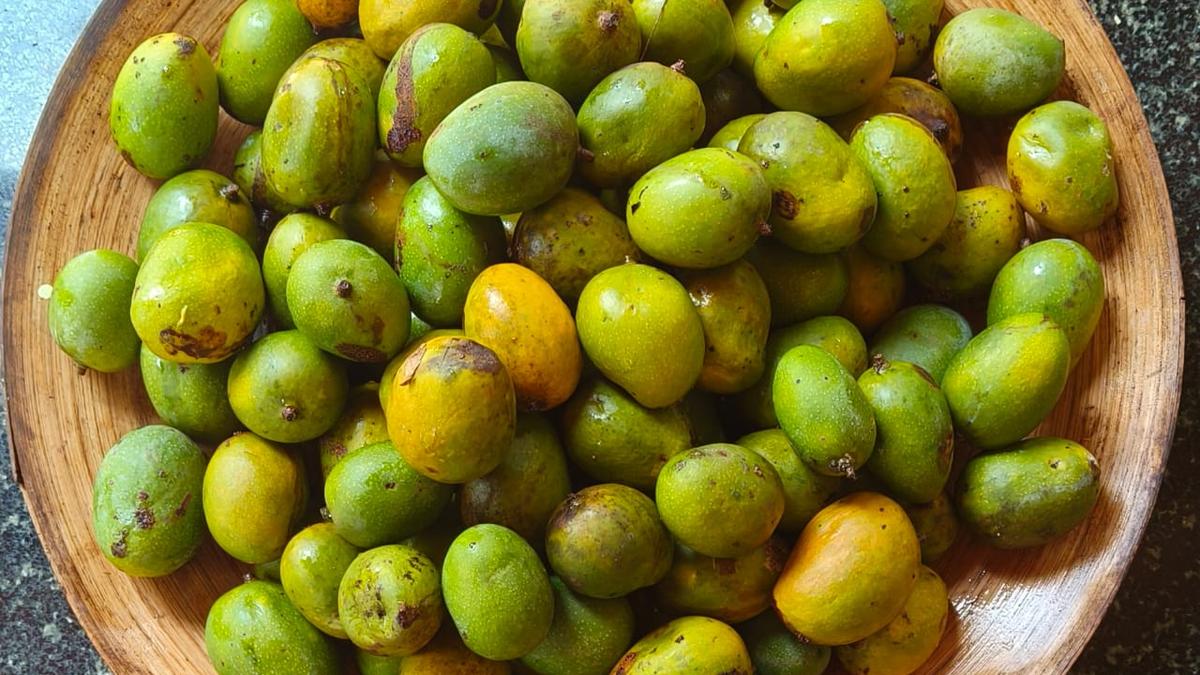Kadukkachi, a native mango variety
| Photo Credit: SPECIAL ARRANGEMENT
The Mallissery mango, found exclusively in the Nedumbassery region of Ernakulam district is the one that goes into the famous tangy Angamaly mango curry. The aromatic Kotturkonam varikka is Thiruvananthapuram’s pride, the Kuttiatoor mango from Kannur is the first native variety to get a GI tag and the Olor mango common in Vadakara region is loved for its size and sweetness. As much as we relish our Alphonsos and Banganapallis, this summer, let us get to know Kerala’s native varieties better.
If one were to navigate through this fascinating mangoscape, one would find a staggering variety — from the favourite bite-sized Chandrakkaran, known for its sweetness (up to 25 Brix), and scent to the ubiquitous Moovandan. Mango collectives in Kerala have been documenting indigenous varieties and creating awareness about them, but there are still a number of unidentified varieties, rich in flavour and unique qualities waiting to be discovered and popularised, says Shyju Machathi, founder of Nattumanchottil, a mango collective based in Kannapuram, Kannur.

Native mango variety Karutha Chungiri found in the Angamaly region
| Photo Credit:
Special Arrangement
The collective will host its ninth native mango festival in May. Unlike a commercial mango festival, this is a closed event, where conservators, scientists, farmers, researchers and mango enthusiasts get together, says Shyju. It would showcase around 100 native varieties from Kerala. “This year, we have participants from the US, China and the UAE,” he adds.

The collective’s conservation efforts led to Kannapuram being declared as an Indigenous Mango Heritage Area. Today, it has evolved into Nattumanchottil Educational and Indigenous Fruit Plants Conservation and Research Trust, winning the Plant Genome Savior Community award instituted by Protection of Plant Varieties and Farmers Right Authority, New Delhi.
Shyju has been working on a comprehensive reference book in two volumes on mango varieties in Kerala. While the first one would feature all named varieties from Kerala, the second would shed light on the unnamed and unique varieties. Notably, the Kerala Police Academy, Thrissur, has tied up with Nattumanchottil to create an indigenous mango conservation and research orchard.

An unnamed native mango variety
| Photo Credit:
Special Arrangement
Sakhil Raveendran, founder of the Indigenous Mango Tree Conservation Project (IMCP), a Thrissur- based collective, believes it is important to bring the native mango to the forefront, especially in this age of instant delivery platforms. “Any variety of mango can be ordered online today, but how much do we know of the mangoes we have in our own backyards?” he asks. The idea is to build a larger community that appreciates and understands native mango varieties. The IMCP has been working towards protecting indigenous mango varieties with the help of public participation. Started in 2019, the collective today has over 55,000 members.
Native mango names
The nomenclature of a native mango is often whimsical, a take on its taste, colour, shape or even the place where it is found. Some have interesting backstories, too, says Sakhil. For instance, a native variety found in the coastal regions in Ernakulam, the Kalluketty, is a mono-embryonic mango variety. The story goes that the tree was layered and since they were mostly planted in coastal areas, the base of the sapling needed to be reinforced with stones (kallu in Malayalam) and hence the name.
The much-loved Priyur, is another example, he adds. The mango variety is believed to have been popularised by priest and social reformer Saint Kuriakose Chavara. It was named Prior after him, as he was the ‘Prior’ or head of the religious congregation. The story goes that at the monastery in Mannanam, Kottayam, there was a mango tree which was planted and taken care of by Kuriakose Chavara, who sent the seedlings to other monasteries and convents and told the members to take care of them.
“Many of these stories are not documented formally. But it is interesting to note that people valued these unique varieties and named them lovingly. However, we have lost some good indigenous varieties owing to neglect,” he adds.
The IMCP is hosting a Manga Mela, which will showcase native varieties. Held in association with the Kerala Agricultural University, Department of Agriculture, District Tourism Promotion Council and the Thrissur Horticulture Society, the two-day event (April 28 and 29 at the Town Hall in Thrissur), will also include sale of saplings and mango products.
Published – April 18, 2025 03:11 pm IST
